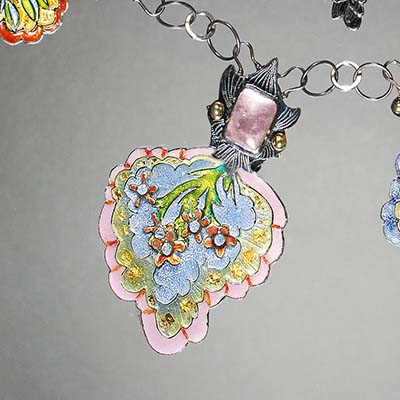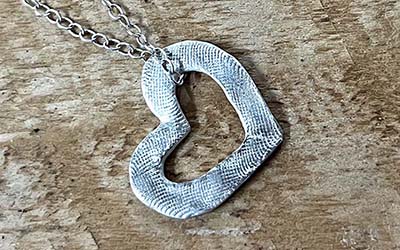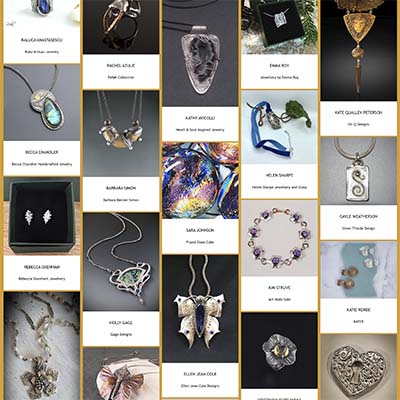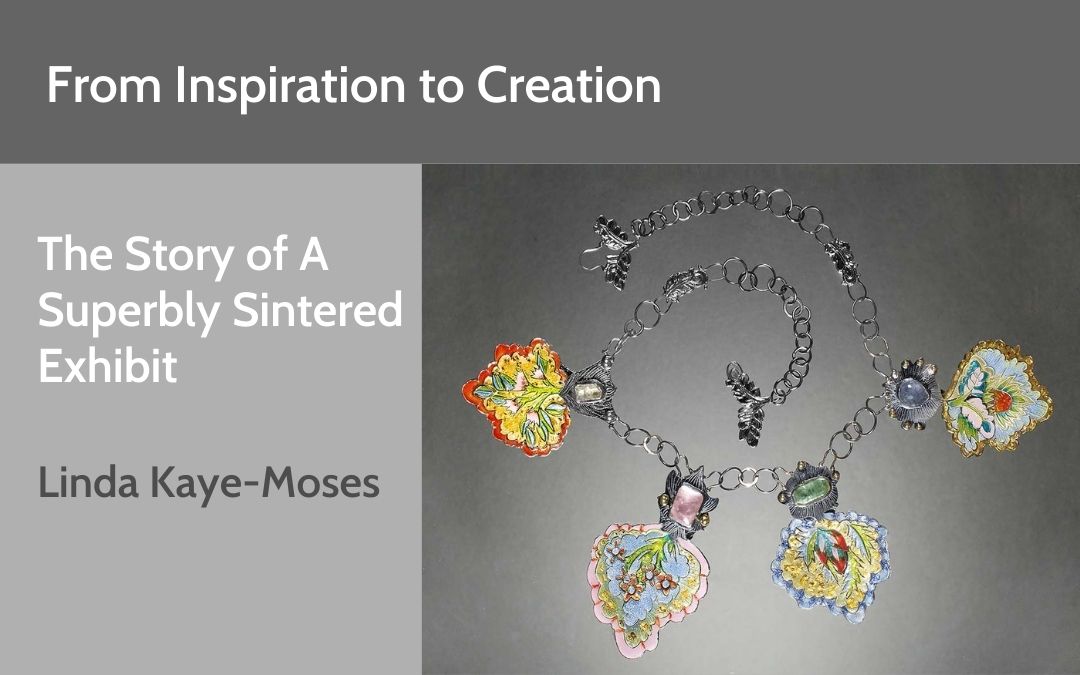Linda Kaye-Moses is a jeweler, author and fiber artist. Her neckpiece ‘Les Fleur de l’Age d’Or’ was juried into the Superbly Sintered: Masterful Designs in Metal Clay Exhibition running at the Sinter Conference in Pittsburgh in May 2022. You can see the piece on this page. The piece is made up of four pendants and Linda has generously outlined the process she used to make them.
 Inspiration
Inspiration
The designs on the four pendants on this neckpiece are based on an 18th century fabric from Colmar in Alsace. I discovered the fabric in a book that anthologized the history of French design. My discovery of the fabric was serendipitous. I have owned this book for over 15 years and periodically return to it for the sheer joy of diving into the designs reproduced on its pages. In 2021 I pulled the book off its place on our bookshelves and wandered through it, being captured almost instantly by the fabric that inspired my neckpiece. This particular fabric was designed and dyed by Jean-Michel Hausmann, who became a famous textile designer in France.
Techniques
Jewelry fabrication techniques, including soldering patination, metal clay, riveting, stone setting; enameling
Process
1. Drawing the Pendants
I began to make this neckpiece by selecting the elements from the fabric patterns that I wanted to use, drawing them, altering them to suit my own design needs, and transferring them to tracing paper. Each of the pendants required an extension of the metal clay to accommodate the gemstone settings, which would be riveted through the back of the settings and metal clay extensions.
2. Enlarging the Pendant Drawings
Before going any further, I traced the drawings and enlarged them on a photocopier to accommodate the shrinkage that would occur during the firing/sintering of the metal clay.
3. Carving the Printing Plate
The enlarged patterns of each of the pendants were then transferred to block printing plates (see video) and the plates were carved using linoleum carving tools.
4. Fabricating the Metal Clay Elements
Fine Silver metal clay (PMC3) was then rolled onto the carved plates, 1.5mm thick (six cards), lifted off the plates, and trimmed and refined. The plates were used to trim out the floral forms and leaves in metal clay, that would be used to add dimension to the pendants and to create the charms and clasp elements of the neckpiece. Four of the leaf elements were joined with paste/slip to form the clasp units. All the metal clay parts were then fired, tumbled in a magnetic finisher for around fifteen minutes.
5. Enameling the Pendants
The pendants were then wet-packed with vitreous enamels and fired.
6. Fabricating the Milled Metal Components
Milled sterling silver and a few 18k gold links were assembled. The settings for the gemstones were fabricated from milled sterling silver and 18k gold. Bails were fabricated and soldered to each setting unit and to the leaf charms, and a hook and a bail were soldered to the clasp units.
7. Joining the Components
The chain, settings, charms and clasps were soldered, joining all the elements together, except the pendants. All the parts, the joined parts and the separate pendants were immersed in Liver of Sulfur until a dark patination was achieved. All the parts were then tumbled in a magnetic finisher for around fifteen minutes.
8. Riveting the Gemstone Settings
Holes were drilled inside all the gemstone settings and in the metal clay extensions on each pendant and 18k gold fabricated ‘nailhead’ rivets were inserted from the back of each pendant into the inside of each setting. Each rivet was upset using a hammer handpiece in a flexible shaft machine or a small riveting hammer.
9. Setting the Gemstones
Because the gemstones were transparent, the upset head of the rivet would be visible beneath the stone. To prevent this, I milled a shim of milled Fine Silver sheet down to around 36 gauge (0.19mm), polished it to a mirror finish and cut and shaped it to insert in each of the settings. This served two purposes: one, these concealed the rivet head; and two, the mirror finish beneath each gemstone reflected the light, otherwise the patinated surface inside the setting, though burnished in the tumbler, would have darkened the colors of the gemstones. The gemstones were then placed in each of their respective settings and burnished in place.
Materials
Fine Silver (sintered PMC3), milled Fine and Sterling Silver sheet and/or wire, and 18k Gold wire, vitreous enamels, tourmaline, apatite, tanzanite
Largest pendant: 2.75” high x 1.75” wide x .25” deep
Total Neckpiece Dimensions:16.5 ” long x 2.75″ high x .25″ deep
Total Hours to Create: 100 hours
All Photography: Evan J. Soldinger
 About the Artist—Linda Kaye-Moses, United States of America
About the Artist—Linda Kaye-Moses, United States of America
Studio jeweler, author and fiber artist Linda Kaye-Moses has exhibited her jewels at major juried shows. She was Jewelry Dept. Head at Interlaken School of Art 1994-2001 and curated the exhibitions: Millennial Metal;The Art of Precious Metal Clay (Bignell Gallery);& Re-Collected/Re-Invented; the Narrative Craft Object (Bignell Gallery). She was a final juror for The Saul Bell Design Awards. Her work has been published in many books, including: In the Picture; Framing the Visual Arts (Oxford University Press, Australia); Art Jewelry Today & Art Jewelry Today 2, 3, & 4; and Fabulous Jewelry from Found Objects.
Her work in metal clay began in 1996 when she coordinated the first open metal clay workshop in the USA, and was invited to a Metal Clay Master Class (1996). She began to teach metal clay that year and taught at many locations in the USA and, in 2001, workshops in New Zealand.
She authored Pure Silver Metal Clay Beads. She has received two Massachusetts Arts Lottery Council Grants, three Massachusetts Cultural Council Professional Development Grants; a Niche Award; and was twice a Saul Bell Design Award Finalist. Her work was recently exhibited in Makers and Mentors: The Art and Life of Snow Farm—The New England Craft Program at the Fuller Craft Museum. She was honored when her neckpiece, Artemisia Liberata won First Prize in the international AMCAW 2021 Alchemy Challenge Competition.
Her work can be seen at The Paradise City Arts Festival, Northampton and Marlborough, MA (paradisecityarts.com for dates) and in The Enamelist Society August conference exhibition, “Alchemy6”, at Arrowmont School of Arts and Crafts, (catalog will be available), or on her website (lindakayemoses.com), where her schedule can also be seen. She will be teaching an enameling on metal clay class for The Enamelist Society conference at Arrowmont School of Crafts in August of 2022 and can be contacted for additional information via her website.
She lives with her husband in an old farmhouse in the Berkshire Hills of Massachusetts, USA, surrounded by lilacs.










